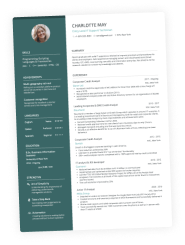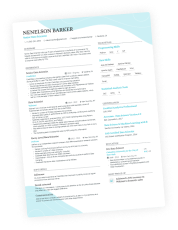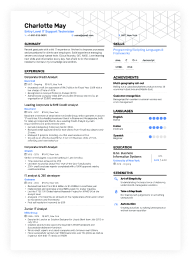Babysitting might seem like a side gig, but it’s one of the clearest signals of reliability you can show on a resume. If you’ve ever balanced homework help, snack time negotiations, and a toddler meltdown in the same afternoon, you’ve already practiced the skills employers want: responsibility, communication, and problem-solving.
So yes, babysitting deserves a place on your resume—as long as you frame it professionally. In this guide, you’ll see exactly how: from formatting tips to strong bullet points and real examples for students, part-timers, and child care professionals.
Key takeaways
- Treat babysitting like real work experience with a title, dates, and responsibilities.
- Place it in the right section depending on how consistent or formal it was.
- Choose a professional job title (Babysitter, Child Care Provider, Family Assistant) to reflect your role.
- Write bullet points with the Action + Context + Result formula.
- Showcase transferable skills like responsibility, communication, and leadership.
- Tailor your babysitting entry to fit the job you’re applying for.
Upload your resume to Enhancv’s ATS Checker to see how it performs instantly.
See how your resume performs when scanned by an ATS
Drop your resume here or choose a file.
PDF & DOCX only. Max 2MB file size.
How to put babysitting on a resume (step by step)
Listing babysitting on a resume isn’t complicated—it just takes a little strategy. Treat it like any other job: give it a clear title, add dates and responsibilities, and show the impact you had.
Step 1. Choose the right placement
Decide which resume section babysitting belongs in:
- Work experience: Use this if you were paid regularly or worked steadily for families.
- Additional experience: Best for occasional or short-term gigs.
- Volunteer work: If it was unpaid or part of community service.
If you’re early in your career, placing babysitting in your main work section signals responsibility, even without other formal jobs.
Step 2. Choose the right job title
The title you use in your babysitting entry matters. It shapes how employers read your experience, so pick one that fits the scope of your work.
- Babysitter: The straightforward choice, best for part-time or after-school jobs.
- Child Care Provider: A more professional option, especially if you've worked with several families.
- Nanny: Works well for a consistent, long-term role with one family.
- Family Assistant: A good fit if your responsibilities go beyond child care, like tutoring or errands.
If you babysat for multiple families, list yourself as “Self-employed” or write “Multiple families” to keep your resume neat without naming everyone individually.”
Step 3. Format it like any other job
Babysitting should follow the same structure as any professional role: job title, employer, location, and dates. Use your first bullet point as a quick scope summary—for example, note the number of children, their ages, and weekly hours up front.
- •Cared for children ages 3–10 across three families, averaging 12–15 hrs/week.
- •Planned age-appropriate activities that encouraged learning and social development.
- •Used Google Calendar to manage pickup times and meal schedules for multiple families.
- •Received consistent positive feedback from parents for reliability and communication.
This structure gives recruiters all the key details at a glance—who you worked with, how often, and in what capacity—while keeping the entry concise and professional.
Step 4. Turn duties into impact
This is where many people undersell babysitting. Writing “Played games with kids” doesn’t say much. Instead, describe the result of your work.
A simple formula helps: Action + Context + Result
- “Coordinated school pickups and bedtime routines for two children, maintaining a 100% on-time record across 9 months.”
- “Designed reading games that doubled a second grader’s weekly reading time.”
- “Created calm-down routines that cut bedtime resistance from 30 minutes to 10.”
Step 5. Add credibility boosters
You can make your babysitting entry more compelling by adding proof points that highlight reliability and skill.
- Certifications:CPR, First Aid, Red Cross Babysitting Basics.
- Tools:Google Calendar (scheduling), Tutor.com (homework help).
- Results: Repeat clients, referrals, or even a simple “95% rebooking rate.”
For an extra touch, you can slip these into your Summary (“Reliable child care provider with CPR certification and steady repeat clients”) or your Skills section (“Child safety, conflict resolution, homework support”).
Author’s take
Create your resume with our builder and get instant feedback to make it stronger.
Is your resume good enough?
Drop your resume here or choose a file. PDF & DOCX only. Max 2MB file size.
Skills from babysitting that employers actually care about
Beyond child care, babysitting builds skills from babysitting that employers value most.
Here are some of the most valuable skills you can confidently pull from your babysitting experience:
Key skills that babysitting adds to your resume
- Responsibility: Parents trusted you with their children and their home. That level of trust signals reliability to any employer.
- Communication: From calming down a cranky toddler to updating parents about schedules, you’ve practiced clear, empathetic communication daily.
- Problem-solving: Whether it was handling a scraped knee or resolving a sibling fight, you’ve shown you can think on your feet.
- Organization and multitasking: Managing meal prep, bedtime routines, and homework at the same time proves strong organizational skills.
- Leadership: Babysitting often means guiding children through activities, setting boundaries, and teaching—all transferable to professional environments.
- Creativity: Turning everyday objects into games or coming up with quick distractions shows adaptability and innovative thinking.
Don’t just list these skills in your Skills section—show them through your experience.
- Principle: Replace vague skill statements with action-driven examples.
- Example: Instead of writing “Good at problem-solving,” write “Created bedtime routines that reduced tantrums and improved sleep consistency.”
This approach makes your resume specific, memorable, and persuasive.
Babysitting on a resume: examples by situation
How you present babysitting depends on where you are in your career journey. Here are tailored examples for different situations:
A high school student applying for a first job
You may not have much formal work experience yet, but babysitting proves you’re reliable and responsible.
- •Cared for two children ages 6 and 9 after school, averaging 10 hrs/week.
- •Organized simple learning games that improved reading comprehension.
- •Managed weekly communication with parents on schedules and progress.
- •Built a reputation for reliability, leading to two referral families.
A college student applying to retail or hospitality
Here, you want to show transferable skills—customer service, organization, and communication.
- •Coordinated care for three families, averaging 20 hrs/week during semesters.
- •Managed shifting schedules and handled last-minute requests with professionalism.
- •Communicated clearly with parents to confirm bookings and gather feedback.
- •Earned repeat clients through reliability, adaptability, and strong interpersonal skills.
A professional applying to teaching or child care
If you’re moving into a childcare or education-related field, position babysitting as a formal experience.
- •Provided care for up to four children simultaneously, ages 2–10, ensuring a safe and nurturing environment.
- •Designed age-appropriate learning and play activities to support academic and social development.
- •Collaborated with parents to align on behavior, routines, and progress toward developmental milestones.
- •Completed Red Cross CPR and First Aid certification to maintain high safety standards.
Use the version that mirrors your career goals. Applying to a coffee shop? Show customer service. Pursuing education? Emphasize teaching experience. Babysitting adapts to your narrative.
PRO TIP
Mention your babysitting experience in your cover letter too—for instance, by describing how it taught you to manage responsibility, communicate under pressure, or support learning. That small story can make your application more personal and memorable.
Common mistakes to avoid
Babysitting proves responsibility—unless it’s written in a way that undersells you. Watch out for these slip-ups.
Here are the pitfalls to steer clear of:
- Listing “babysitting my siblings” as work experience. Family care is valuable, but unless it's structured and consistent, it’s better framed under volunteer work or not listed at all.
- Using casual or vague language. Phrases like “watched kids” or “played games” don’t tell an employer anything meaningful. Translate tasks into outcomes instead.
- Skipping details. Leaving out the number of children, their ages, or the time frame makes the role look less professional.
- Forgetting transferable skills. Babysitting isn’t only about childcare—it shows organization, leadership, and reliability that apply to many fields.
- Not tailoring to the job you want. A resume for retail can emphasize communication and time management, while a teaching resume should spotlight learning support and creativity.
Before finalizing your resume, ask yourself, “Would someone outside the child care world understand the value I delivered?” If the answer is no, rewrite until the skills and results are clear.
Conclusion
Every babysitting job carries weight. Managing after-school routines, calming down meltdowns, or keeping kids engaged requires the same mix of responsibility, patience, and quick problem-solving that employers value in any role.
The next time you add babysitting to your resume, don’t undersell it. Show it for what it really is: Proof that you’ve already handled real responsibility—the kind employers trust you with on day one.
Make one that's truly you.



